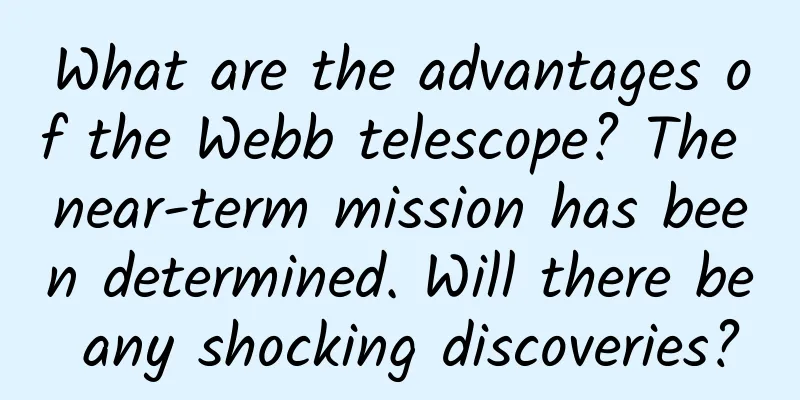What are the advantages of the Webb telescope? The near-term mission has been determined. Will there be any shocking discoveries?

|
The Hubble Space Telescope (hereinafter referred to as "Hubble"), which has attracted much attention for decades, has been neglected recently, and people's attention has shifted to the "newcomer" of space telescopes, the Webb Telescope (hereinafter referred to as "Webb"). We should not forget the great contributions it has made to human exploration of the universe just because Hubble is old and no longer attractive. So, what is the difference between "Hubble" and "Webb", and what is the strength of the up-and-coming "Webb"? Simply put, the differences between the two telescopes are concentrated in three aspects: First, the observation methods are different. Hubble mainly uses visible light and ultraviolet light for observation, with wavelengths between 200 nanometers and 2.4 microns, while Webb observes with wavelengths between 600 nanometers and 28 microns, mainly in the infrared band. Infrared is invisible light, has a strong ability to penetrate clouds and fog, and can observe farther and clearer images. Secondly, the size of the main mirror is different. The main mirror of Webb is 6.5 meters, 2.7 times that of Hubble. Webb's light-gathering ability is more than 6 times that of Hubble. Therefore, Webb can see darker and more distant objects than Hubble. Hubble can see objects of magnitude 30, and the farthest is 13.4 billion light-years. Theoretically, Webb can see 13.8 billion light-years, 400 million light-years further than Hubble, and can see the infant universe at the beginning of the Big Bang. Thirdly, the orbital heights are different. Hubble is in low Earth orbit, only 575 kilometers from the Earth, while Webb is located at the L2 Lagrange point, 1.5 million kilometers from the Earth. Therefore, one is a satellite of the Earth orbiting the Earth, and the other is a satellite of the Sun orbiting the Sun. They are at completely different levels. Compared with Hubble, Webb is far away from the Earth and other celestial bodies, and the environment is quieter, without the interference of atmospheric turbulence. Of course, the "Webb" is not as good as the "Hubble", such as it is too far away and cannot be maintained, so it must succeed at one time, otherwise all the previous efforts will be wasted; and the Hubble had problems as soon as it was launched into space. Since it is in low-Earth orbit, space shuttles and astronauts have been sent for maintenance many times, otherwise it would not have been possible to achieve its current achievements. In terms of cost, Webb cost $10 billion when it was launched, which is five times the total cost of Hubble's manufacturing, operation and maintenance over the years. Webb was designed and built over 25 years to ensure it was foolproof, with launch postponed and revised repeatedly. Hubble's service life has reached 22 years, while Webb's planned service life is only 10 years. What has the Webb telescope already seen? In general, the Webb telescope has just been debugged. Because it uses infrared bands to observe distant celestial bodies, the environmental conditions required are very harsh, there can be no heat radiation around, and the ambient temperature of the telescope itself must be reduced to near absolute zero. Absolute zero is generally called 0 K, expressed as -273.15℃ in Celsius. Any object with a temperature higher than absolute zero will emit infrared rays. Therefore, the Webb must operate in a space far away from the earth with little or no thermal radiation interference, and the telescope itself must be cooled with its own liquid helium. To block the sun's radiation, Webb is equipped with a huge parasol that is as big as a tennis court. Webb's primary mirror and important instruments are hidden in the shade of the parasol, always peering at the universe in the cold darkness. Webb's primary mirror must be cooled to below minus 223 degrees Celsius, the near-infrared instrument to below minus 233 degrees Celsius, and the mid-infrared instrument to below minus 266 degrees Celsius. During launch, in order to fit the huge telescope into the narrow rocket head, the main mirror and parasol of the entire telescope have to be folded and slowly opened when they are about to reach the destination. After opening, the focal length of the lens has to be readjusted, which takes a certain amount of time. The Webb was launched from a French base at 13:15 a.m. local time on December 25, 2021. A month later, it reached the scheduled L2 Lagrange point, opened its primary mirror and sunshield, and took its first photo. When NASA released this photo on February 12, it disappointed many people. There are 18 blurry stars in this picture. NASA claims that this is a composite of more than 1,500 photos taken by Webb in 25 hours. This is just a photo of a star called HD 84406, but it is just a different angle image taken by the 18 hexagonal small mirrors of the Webb main mirror, because these 18 small mirrors have just been extended and have not yet focused. It turned out that this was a test photo to obtain the focusing parameters. The 18 small lenses acted independently, so of course there was astigmatism. After adjustment, when the starlight from the 18 small mirrors was focused on one point, an exciting scene appeared. A bright and clear star appeared, indicating that "Weber" successfully arrived at its position and everything was normal! In the following months, Webb has been fine-tuning. On March 16, the Webb science team released another picture of a bright star named 2MASS J17554042+6551277. This picture is no longer a composite picture, but a single picture of a star taken by all the lenses working together. Scientists said that this is the highest resolution infrared image ever taken in space. On May 2, 2022, NASA announced that Webb had completed calibration on April 28. After a comprehensive review, the four scientific instruments on board Webb were able to capture sharp, well-focused images. This means that Webb has entered its official service period and is beginning to show its capabilities. What is Weber going to see now? Hubble has "seen" stars within 12.9 billion light-years and galaxies within 13.4 billion light-years. Can Webb surpass that? NASA has long claimed that Webb will bring even greater surprises to people, and will push Hubble's vision forward by another 400 million light-years. That means that on the basis of Hubble's ability to see galaxies 13.4 billion light-years away, it will be able to see celestial bodies 13.8 billion light-years away. We know that the Big Bang occurred 13.8 billion years ago. If we can see 13.8 billion light years away, we can see the first light of the Big Bang! The Big Bang theory is still a hypothesis so far. If we can see the first light of the Big Bang 13.8 billion light years away, this scientific hypothesis will be verified. What an amazing scientific feat! From then on, the history of the development and evolution of the universe will become clearer and clearer, thus solving the questions of where the universe came from, where it is going, and what the future will be like; it will also solve the questions that have plagued mankind for thousands of years: where humans came from, where they are going, and their future destination. However, scientists do not seem to be in a hurry to solve the mystery of "farsightedness", but to solve the "nearsightedness" goal first. Just two days ago, NASA announced the near-term mission of "Webb" to observe two planets. These are two typical exoplanets (extrasolar planets, the same below), which are called hot "super-Earths" by people. One of them is called LHS 3844 b and the other is called 55 Cancri e, which are 49 light-years and 41 light-years away from us respectively. Both planets are rocky planets, but they are very close to their host stars and are therefore very hot. Scientific exploration and research believe that life and civilization can generally only occur on planets. In the solar system, except for the Earth, no life has been found on any other planets, satellites or dwarf planets, let alone signs of civilization. Therefore, as early as the last century, scientists began looking for planets outside the solar system. To date, the scientific community has discovered 5,000 exoplanets through various telescopes. The closest of these exoplanets is only 4.22 light-years away from us, and the farthest is tens of thousands of light-years away. However, with the current observation methods of human beings, the most advanced telescopes cannot even see the stars outside our solar system clearly, let alone the planets outside our solar system, even the Proxima Centauri, which is only 4.22 light years away. This is because they are too far away from us and cannot form a minimum resolution angle on our retina. Even the largest telescope can only see a point of light. Planets are even harder to see, and most of them are discovered through the occultation method or the radial velocity method. The so-called occultation method is that when a planet is sandwiched between us and a star, it will block a little bit of the star's light. By analyzing the light variation of the star through instruments, we can know whether there is a planet in the middle; and then calculate the distance and mass of the planet and the star based on the gravitational perturbation caused by the interaction between the planet and the star. Therefore, people have high expectations for Weber. Since exoplanets are basically invisible with optical telescopes, Webb uses infrared observations. As long as an object has temperature, it will emit infrared rays. In this way, Webb can "see" planets that are invisible to optical telescopes. Therefore, people hope that Webb can help solve the mysteries of some exoplanets, even those that are very close. This is what I call a "nearsighted" target. LHS 3844 is a red dwarf star with low luminosity. The planet LHS 3844 b orbiting this red dwarf has a diameter about 1.3 times that of the Earth and is only about 900,000 kilometers away from the main star. However, due to the low temperature of the red dwarf, the energy radiated to this planet is not enough to melt the rocks, and the surface temperature is only about 525 degrees Celsius, which is slightly higher than the surface temperature of Venus. LHS 3844 b orbits its star at a relatively fast speed, taking 11 hours to complete one revolution. The problem that Webb is going to solve is to use its onboard mid-infrared instrument MIRI to analyze the mid-infrared spectrum to obtain the different rock compositions of the planet, thereby determining its surface composition and whether it has an atmosphere. 55 Cancri e is a rocky planet with a mass 8.63 times that of the Earth. It is only about 2.3 million kilometers away from its star and has an orbital period of 18 hours. Its host star is a sun-like star. The sun is of course much hotter than a red dwarf, so this planet is very hot, with a surface temperature of 2400 degrees Celsius during the day. The temperature of molten rock is only 900-1200 degrees Celsius, and the melting point of iron is only 1535 degrees Celsius, so the sun-facing side of this planet can only be molten. Some studies believe that this planet has been tidally locked to the star, that is, it always faces the star, so one side of the planet is always molten hot, while the side facing away from the star is always cold; other studies believe that this planet may have a thick atmosphere composed of oxygen or nitrogen. But these are not certain and there are disputes. Optical telescopes cannot distinguish these, but the infrared spectrum analysis of the Webb telescope may solve these mysteries. And studying these two planets may be of great help in understanding what the early formation of the Earth was like. I think the exoplanets alone will keep Webb busy for a while in its later mission. Among the more than 5,000 exoplanets that have been discovered, there are many Earth-like planets in the habitable zone. These planets are often hyped as Earth's big cousin, Earth's brother, Earth 2.0, etc. Some studies have shown that some planets may have liquid water and atmosphere, and perhaps life. However, since optical telescopes cannot see it, we can only guess. Although there have been telescopes such as the Wide Field Infrared Survey Telescope (WISE) and the Spitzer Telescope (SST) that use infrared bands for observation in the past, they are dwarfed by the "Webb" and are too small. In terms of the diameter of the main mirror alone, the "Wide Field" is only 40 cm, the "Spitzer" is only 85 cm, and the "Webb" is 6.5 meters. Therefore, the recognition and clarity they obtain are completely different (see the picture above). This is the great value of Weber. People not only hope that Weber will be able to see the origin of the universe in the future, but also hope to discover extraterrestrial life and civilization. If this can be achieved, it will be a huge breakthrough in human scientific discovery and shocking the world. What do you think about this? Welcome to discuss, thank you for reading. The copyright of Space-Time Communication is original. Please do not infringe or plagiarize. Thank you for your understanding and cooperation. |
<<: Can “not eating after noon” help you lose weight? A year-long experiment found…
>>: What exactly happened when I blacked out after drinking?
Recommend
Electric Technology Car News: Are cheap MPVs bad products? The Lifan Xuanlang, which starts at RMB 70,000, makes it harder for joint venture cars to sell.
Today's domestic MPV market can be said to ha...
From the perspective of Android development, let’s talk about Airbnb’s Lottie!!!
1. Introduction Have you ever met some designers ...
Do Java arrays have to be initialized before they can be used?
An array is a composite structure provided by mos...
Cow "matrix": giving cows a virtual grassland, away from the pain of crowded farms
Although the fourth installment of The Matrix suf...
It is actually a close relative of spiders!
Nie Huang's "Illustrated Book of Sea Tal...
Huawei AppGallery Connect Salon Guangzhou Station successfully concluded
On December 18, the Huawei AppGallery Connect Stu...
Having trouble breathing and dry cough, but can’t find the cause? Learn more about this disease!
Author: Fang Baomin, Chief Physician, Beijing Hos...
Anemia, what are the misunderstandings about iron supplementation
Iron is an important essential trace element for ...
Tesla: 1Q20 revenue increased 38% year-on-year, with strong performance in the Chinese market
According to Tesla's first quarter 2020 finan...
Solution Consulting · 2021 Hot Product Solution + Industry Solution Teacher Zhang Yang will take you through the report
Solution Consulting · 2021 Hot Product Solution +...
What is the algorithm of Tik Tok’s recommendation mechanism?
The reason why Tik Tok is so popular is definitel...
Learning skateboarding from scratch - from beginners to fancy tricks
Learning Skateboarding from Scratch - Introductio...
Taking Pinduoduo as an example, we will analyze the paid membership tier model and operation ideas
This article takes the mainstream payment system ...
Thales: The first person in the childhood of science丨Expand the scroll
Thales, an ancient Greek mathematician and philos...









